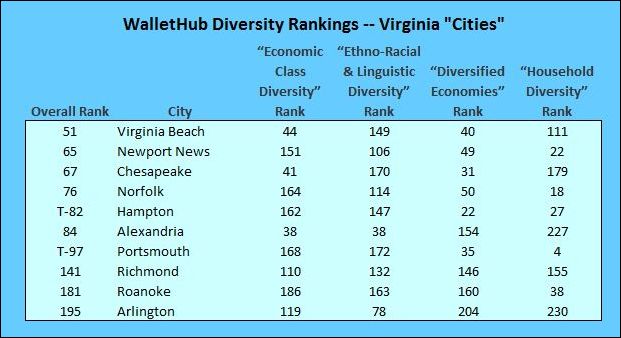by James A. Bacon
A popular body of thought today hails “diversity” as one of the United States’ great strengths. That may be difficult to imagine at the moment, with race relations more strained than at any time since the school busing controversies of the 1970s, but the idea has much to recommend it. Innovation, argued Frans Johansson in his book “The Medici Effect,” comes at the intersection — the intersection of cultures, the intersection of academic disciplines, the intersection of industries. Insofar as the world is evolving into an innovation-driven economy, metropolitan regions that entertain a wide diversity of perspectives arguably have greater potential for artistic, cultural and entrepreneurial innovation.
WalletHub, a compiler of imaginative geographical rankings, has devised an intriguing set of metrics to compare the diversity of 230 sample U.S. cities based upon their rankings in a larger group of 350 cities. (Interestingly, Washington, D.C.-based WalletHub counts Arlington, a county, as a city.) The twelve metrics used in 2015’s Most Diverse Cities in America index fall into four broad categories: economic class diversity; ethno-racial & linguistic diversity; economic diversity; and household diversity.
By way of explanation, the compilers of the diversity rankings write:
Rapid diversification is one of the main drivers of our economic success. In recent decades, waves of immigration as well as financial and social mobility have not only changed the face of America but also ushered in a wealth of fresh perspectives, skills and technologies.
And thanks to its ever-expanding diversity, the U.S. remains forward-looking and extremely adaptable to change. According to the United Nations Industrial Development Organization, economies generally fare better when they openly embrace and capitalize on new ideas. Conversely, those relying on old ways and specialized industries tend to be more susceptible to the negative effects of market volatility.
There is no question that cultural diversity breeds innovation. A classic example is the interaction of many musical styles rooted in local American cultures — from African-American blues, white Appalachian bluegrass, Cajun zydeco — that gave rise to jazz, country, rock n roll, soul, rap, punk and many more musical styles. Musically, the U.S. is the most innovative country in the planet, with no peer. On the other hand, some might take issue with the notion that socio-economic and educational diversity — another way of describing inequality — is a boon to innovation. Likewise, one could argue that industry diversity is a hamper to innovation; innovation is most likely to occur in regions with powerful industry clusters like those seen in the Silicon Valley (digital), New York (financial) or Los Angeles (film).
It would be interesting to run correlations between WalletHub’s diversity metrics and metrics of economic performance to find which factors show the strongest relationships. Complicating any such analysis is the fact that, while WalletHub is measures the diversity of “cities,” cities are embedded in larger metropolitan areas, which may or may not share the same diversity characteristics.
With that important caveat, it is interesting to view the diversity of Virginia cities:
 (For a detailed breakdown of all 12 metrics, click here.)
(For a detailed breakdown of all 12 metrics, click here.)
If there is a strong correlation between diversity and innovation, Hampton Roads cities should be the economic dynamo of Virginia. Let’s just say that that’s a stretch. Likewise, Arlington is the least diverse “city” in the state — just too darn many affluent and well-educated residents. Yet somehow it manages to have one of the highest incomes of any jurisdiction in the U.S.
Frankly, I don’t find the data terribly useful in their current incarnation. But I give WalletHub credit for its creativity in dreaming up new metrics. I hope the company recycles this feature in 2016 in a format that compares metropolitan regions rather than core cities. For wonks like me, the data could prove endlessly fascinating.


